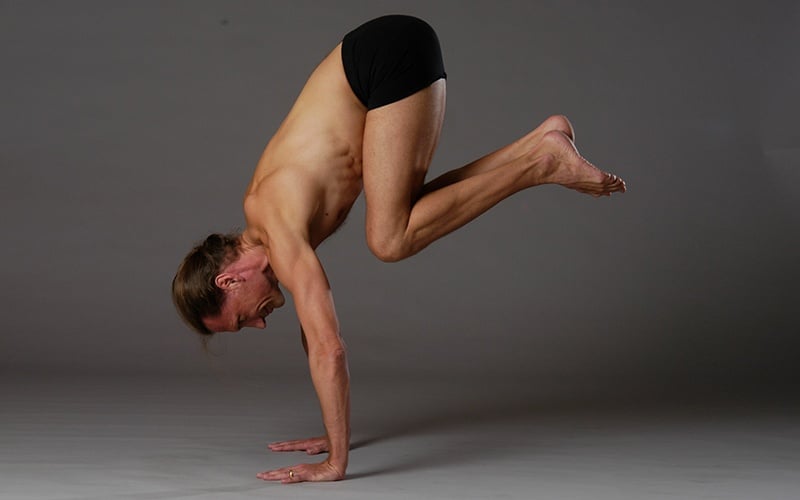I often get asked how one can jump through without touching the floor. Of course, technique is important but it is not all there is. You also need to have a basic level of strength and trunk flexion. If that is not there no level of technique will get you through without touching the floor.
Lollasana
To check whether your strength is sufficient enter Lollasana by crossing your ankles and try to lift off the floor. If you can get your feet off the floor you have completed the first condition to jumping through. Hold Lollasana for as long as you can. Add on one breath every day until you can hold it for ten breaths. Then gently begin to swing back and forth without dragging your feet over the floor. Eventually you will be able to increase the amplitude of the swinging movement to such an extent that you can swing through to Dandasana, then pick up the weight and swing back to Chaturanga Dandasana.
Blocks
But what if you can’t get your feet off the floor in Lollasana at all? In this case you need to place blocks under hands to create enough ground clearance. From there simply extend the time you can hold your feet off the floor until you can hold them up for 10 breaths. It may be helpful to practice this several times a day to build strength fast enough. You may find that there are two separate aspects to getting off the floor. One is shoulder strength which is easy to generate in this posture. The other one is trunk flexion which is chiefly performed by your rectus abdominis. If your rectus is already developed to some extend you may be able to fire it up enough by simply performing Lollasana. If, however, your rectus is completely switched off it can be more feasible to first get it firing by isolating it in trunk curls and hip/leg raises.
Once you can perform swinging back and forth in Lollasana it is time to reduce the height of the blocks. You may be able to source thinner blocks but it may be easier to simply take some thick books (telephone books used to be good but they are on the way out) or even a few thin ones so that you can reduce the height gradually. Once you can remove any blocks/books you are now ready to look at the actual technique to jumping through.
Technique for jumping through
At first you may execute this movement using momentum. With increased proficiency you will be able to jump through with little or no momentum while still clearing the floor. The key to effortless performance here is to connect the breath to the bandhas. As long as we are airborne in the jump, we must continue to inhale, as the inhalation has a lifting and carrying effect. Once the lift-through is complete we initiate the exhalation to lower down.
To learn this movement, it should be divided into two clearly distinguishable separate phases. Phase 1 is hopping forward into an arm balance with the shoulders over the wrists and the hips and folded legs lifted high. Phase 2 consists of letting the torso and legs slowly swing through the arms, using the shoulders as an axis. As you swing through, suck the feet up into the abdomen and the knees into the chest to clear the floor. With the last of the inhalation, straighten the legs into Dandasana, still suspended in the air. With the exhalation, slowly lower down. Performing the movement in this way will establish a firm connection between breath and bandhas. It will also strengthen the abdomen and the low back, preparing for the challenging backbends and leg-behind-head postures in the later sequences.
Role of the Inhalation
The inhalation has a natural upward lifting function; the exhalation has a grounding and rooting function. Imagine the autumn wind playing with leaves and effortlessly lifting them off the floor. The same power is used in the vinyasa movement. The inhalation inspires the lift, with the shoulder and arm muscles providing the structural support. This is only possible with Mula and Uddiyana Bandha engaged. The inhalation reaches down, hooks into the bandhas and lifts the body up like an elevator. Movement must follow the breath. If the breath is connected to the bandhas, it will move the body effortlessly and one will feel light and rejuvenated after the practice. If the bandhas are not firmly established, one might feel drained and exhausted after practice because energy has been lost. Feel how the inhalation reaches down and attaches itself to the engaged pelvic floor and lower abdominal wall. Continue to inhale, creating a suction that lifts your trunk off the floor. Support this lift with the frame and action of your arms and shoulders.


Gregor, great breakdown, but now you please need to give us some tips for connecting with the elusive bandhas.
Namaste,
Mark